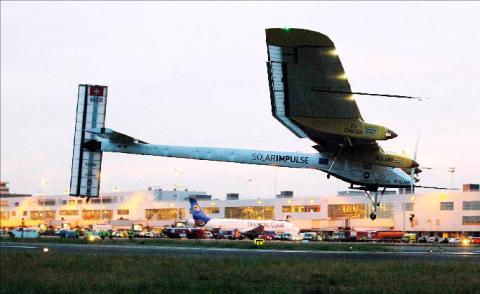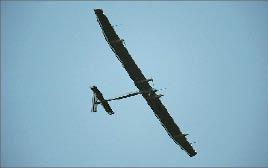Pioneering Swiss solar-powered aircraft Solar Impulse landed in Brussels on Friday after completing its first international flight, 13 hours after it took off from Switzerland.
“I captured more energy than I used,” said pilot Andre Borschberg as he descended from the plane amid the applause of hundreds of people including Belgium’s Crown Prince Philippe, who had followed Solar Impulse’s long descent from a helicopter.
“I flew with the power of a scooter,” Borschberg added.

Photo: Reuters
“This is wonderful,” said Bertrand Piccard, joint founder and president of the Solar Impulse project.
The single-seater had lifted off gently in clear blue skies from Payerne airbase at 8:40am after being delayed by early morning mist.
It covered the roughly 480km from western Switzerland to Brussels airport, flying over France and Luxembourg at 3,600m.

Photo: AFP
“With this flight, we would like to encourage politicians to opt for more ambitious energy policies,” Piccard said before the aircraft landed.
He also called for “a change in mentalities to encourage people to use new [green] technologies” and stop wasting fossil energies.
“It is crazy that mankind wastes a billion tonnes of oil an hour,” he added. “Who wants to believe that we will keep planes that burn up so much fuel?”
“The flight is going really well, I have just flown over Liege, it’s a real pleasure to enter Belgian airspace,” Borschberg said as the dragonfly-like experimental and emissions-free aircraft cruised at 50kph.
“The view I have here is extraordinary,” the Swiss pilot added in a live feed over the Internet. “I’m above the clouds, for now I’m taking advantage of the blue sky.”
Solar Impulse HB-SIA, which has the wingspan of a large airliner, but weighs no more than a sedan, made history in July last year as the first manned plane to fly around the clock and through the night on the sun’s energy.
It holds the endurance and altitude records for a manned solar-powered airplane after staying aloft for 26 hours, 10 minutes and 19 seconds above -Switzerland, flying at 9,235m.
The high-tech plane has since flown several times, notably between Geneva and Zurich airports, but the journey to a busy airport in Brussels through crowded airspace was regarded as a new test.
“Flying an aircraft like Solar Impulse through European airspace to land at an international airport is an incredible challenge for all of us, and success depends on the support we receive from all the authorities concerned,” said Borschberg, who also piloted July’s flight.
The HB-SIA relies on 12,000 solar cells on its 64m wings to charge the batteries that provide the energy for the 10-horsepower electric motors driving four propellers. Its record-breaking flight last year demonstrated its capacity to store up enough energy to fly through a summer night.
The showcase for green technology will be on display at Brussels airport until May 29 before flying to the international air show at Le Bourget in Paris from June 20 to June 26.
“This time, we have a real airplane — flying —- proof that new technologies can reduce our dependence on fossil energy,” Piccard said.
The Solar Impulse team is planning to fly even further, including possible transamerican, transatlantic and round-the-world flights — in stages — in 2013 and 2014 using a slightly larger aircraft.
Asked about upping the speed, Borschberg said: “That’s not the aim of this plane for now.”
Piccard, himself the first man along with Briton Brian Jones to fly non-stop around the world in a balloon, comes from a dynasty of pioneers.
His grandfather Auguste Piccard twice beat the record for reaching the highest altitude in a balloon, in 1931 to 1932.
His late father Jacques Piccard was a deep sea explorer who holds the record for traveling to the deepest point underwater, 10,916m below sea level in the Marianas Trench in the Pacific.

Taiwan Semiconductor Manufacturing Co (TSMC, 台積電) last week recorded an increase in the number of shareholders to the highest in almost eight months, despite its share price falling 3.38 percent from the previous week, Taiwan Stock Exchange data released on Saturday showed. As of Friday, TSMC had 1.88 million shareholders, the most since the week of April 25 and an increase of 31,870 from the previous week, the data showed. The number of shareholders jumped despite a drop of NT$50 (US$1.59), or 3.38 percent, in TSMC’s share price from a week earlier to NT$1,430, as investors took profits from their earlier gains

In a high-security Shenzhen laboratory, Chinese scientists have built what Washington has spent years trying to prevent: a prototype of a machine capable of producing the cutting-edge semiconductor chips that power artificial intelligence (AI), smartphones and weapons central to Western military dominance, Reuters has learned. Completed early this year and undergoing testing, the prototype fills nearly an entire factory floor. It was built by a team of former engineers from Dutch semiconductor giant ASML who reverse-engineered the company’s extreme ultraviolet lithography (EUV) machines, according to two people with knowledge of the project. EUV machines sit at the heart of a technological Cold

AI TALENT: No financial details were released about the deal, in which top Groq executives, including its CEO, would join Nvidia to help advance the technology Nvidia Corp has agreed to a licensing deal with artificial intelligence (AI) start-up Groq, furthering its investments in companies connected to the AI boom and gaining the right to add a new type of technology to its products. The world’s largest publicly traded company has paid for the right to use Groq’s technology and is to integrate its chip design into future products. Some of the start-up’s executives are leaving to join Nvidia to help with that effort, the companies said. Groq would continue as an independent company with a new chief executive, it said on Wednesday in a post on its Web

CHINA RIVAL: The chips are positioned to compete with Nvidia’s Hopper and Blackwell products and would enable clusters connecting more than 100,000 chips Moore Threads Technology Co (摩爾線程) introduced a new generation of chips aimed at reducing artificial intelligence (AI) developers’ dependence on Nvidia Corp’s hardware, just weeks after pulling off one of the most successful Chinese initial public offerings (IPOs) in years. “These products will significantly enhance world-class computing speed and capabilities that all developers aspire to,” Moore Threads CEO Zhang Jianzhong (張建中), a former Nvidia executive, said on Saturday at a company event in Beijing. “We hope they can meet the needs of more developers in China so that you no longer need to wait for advanced foreign products.” Chinese chipmakers are in